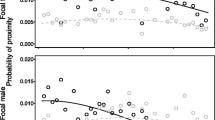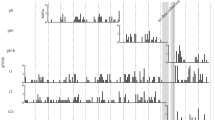Abstract
The sexual relationships of 15 adult male rhesus macaques (Macaca mulatta), of one social group in the Cayo Santiago colony, Puerto Rico, were studied during the 1981 mating season. Two criteria were used to determine whether or not a focal male was in consort in a given 20-min observational sample. One hundred and thirty-two consortships were recorded. The distribution and duration of all consortships, and the distribution of those consortships that coincided with the estimated time of conception, were positively correlated with male dominance rank and length of tenure. Correlations with dominance were stronger than those with tenure. Older females had more consortships with focal males than younger females. There was no relationship between female rank and the distribution of consortships. Consortships did not give exclusive access to receptive females although they may do in feral situations.
Males were primarily responsible for maintaining proximity in about two thirds of consortships. The four top-ranking males were primarily responsible in all but one of their consortships. Almost all of those in which the female was primarily responsible involved younger, slightly lower-ranking males. This pattern may have resulted from the females being attracted to the latter males although other interpretations are possible. The partner who was primarily responsible for maintaining proximity also tended to be the predominant groomer, supporting the view that grooming plays a role in the maintenance of sexual consortships. Almost a third of consortships were with females who had conceived, suggesting that males could not accurately assess female reproductive state. Consortships maintained by the male were longer than those maintained by the female. Males may try to increase their chances of fertilising a female by prolonging the consortship. High-ranking males may have been more successful at this, resulting in the positive correlation between male dominance rank and consortship duration.
Similar content being viewed by others
References
Altmann, J., 1974. Observational study of behaviour: sampling methods.Behaviour, 49: 227–265.
, 1980.Baboon Mothers and Infants. Harvard Univ. Press, Cambridge, Massachusetts.
Berenstain, L. &T. Wade, 1983. Intrasexual selection and male mating strategies in baboons and macaques.Int. J. Primatol., 4: 201–235.
Bernstein, I. S., 1976. Dominance, aggression and reproduction in primate societies.J. Theor. Biol., 60: 459–472.
,R. M. Rose, &T. P. Gordon, 1977. Behavioural and hormonal responses of male rhesus monkeys to females in the breeding and nonbreeding seasons.Anim. Behav., 25: 609–614.
Caldecott, J., 1984. Coming of age inMacaca.New Sci., 1369: 10–13.
Carpenter, C. R., 1942. Sexual behavior of free-ranging rhesus monkeys (Macaca mulatta) 1. Specimens, procedures, and behavioral characteristics.J. Comp. Psychol., 33: 113–142.
Chapais, B., 1981. Adaptiveness of social relationships between adult rhesus monkeys. Ph.D. thesis. Univ. of Cambridge, Cambridge.
, 1983a. Reproductive activity in relation to male dominance and the likelihood of ovulation in rhesus monkeys.Behav. Ecol. Sociobiol., 12: 215–228.
, 1983b. Male dominance and reproductive activity in rhesus monkeys. In:Primate Social Relationships,R. A. Hinde (ed.), Blackwell, Oxford, pp. 267–270.
, 1983C. Structure of the birth season relationships among adult male and female rhesus monkeys. In:Primate Social Relationships,R. A. Hinde (ed.), Blackwell, Oxford, pp. 200–208.
Conaway, C. H. &C. B. Koford, 1964. Estrous cycles and mating behavior in a free-ranging band of rhesus monkeys.J. Mammal., 45: 577–588.
Curien-Cohen, C. H., D. Yoshihara, L. Luttrell, K. Benforado, J. W. MacCluer, &W. H. Stone, 1983. The effects of dominance on mating behavior and paternity in a captive group of rhesus monkeys (Macaca mulatta).Amer. J. Primatol., 5: 127–138.
Dewsbury, D. A., 1982. Dominance rank, copulatory behaviour and differential reproduction.Q. Rev. Biol., 57: 135–159.
Drickamer, L. C. &S. H. Vessey, 1973. Group changes in free-ranging rhesus monkeys.Primates, 14: 359–368.
Duvall, S. W., I. S. Bernstein, &T. P. Gordon, 1976. Paternity and status in a rhesus monkey group.J. Reprod. Fertil., 47: 25–31.
Eaton, G. G., 1974. Male dominance and aggression in Japanese macaque reproduction. In:Reproductive Behaviour,W. Montagna &W. A. Sadler (eds.), Plenum Press, New York, pp. 287–297.
, 1978. Longitudinal studies of sexual behavior in the Oregon troop of Japanese macaques. In:Sex and Behavior: Status and Prospectus,T. E. McGill,D. A. Dewsbury, &P. D. Sachs (eds.), Plenum Press, New York, pp. 35–60.
Enomoto, T., 1974. The sexual behavior of Japanese monkeys.J. Human Evol., 3: 351–372.
Fedigan, L. M. &H. Gouzoules, 1978. The consort relationship in a troop of Japanese macaques. In:Recent Advances in Primatology, Vol. 1. Behaviour,D. J. Chivers &J. Herbert (eds.), S. Karger, Basel, pp. 493–495.
Gouzoules, H., S. Gouzoules, &L. M. Fedigan, 1983. Male Japanese monkeys: are female reproductive state cues available?Amer. J. Primatol., 4: 344. (Abstract only)
Hanby, J. P., L. T. Robertson, &C. H. Phoenix, 1971. The sexual behavior of a confined troop of Japanese macaques.Folia Primatol., 16: 123–143.
Hausfater, G., 1975.Dominance and Reproduction in Baboons (Papio cynocephalus): a Quantitative Analysis. Contributions to Primatology, Vol. 7, S. Karger, Basel.
Hill, D. A., 1985. Social relationships of adult males in a free-ranging group of rhesus monkeys. Ph.D. thesis, Univ. of Cambridge, Cambridge.
, 1986a. Seasonal differences in the social relationships of adult male rhesus macaques. In:The Cayo Santiago Macaques,R. G. Rawlins &M. Kessler (eds.), SUNY Press, New York, pp. 159–172.
, 1986b. Social relationships between adult male and immature rhesus macaques.Primates, 17: 425–444.
Hinde, R. A. &S. Atkinson, 1970. Assessing the roles of social partners in maintaining mutual proximity as exemplified by mother-infant relations in rhesus monkeys.Anim. Behav., 18: 169–176.
Kaufmann, J. H., 1965. A three-year study of mating behavior in a free-ranging band of rhesus monkeys.Ecology, 46: 500–512.
Lindberg, D. G., 1971. The rhesus monkey in Northern India: an ecological and behavioral study. In:Primate Behavior, Vol. 2,L. A. Rosenblum (ed.), Academic Press, pp. 1–106.
, 1973. Grooming behavior as a regulator of social interactions in rhesus monkeys. In:Behavioral Regulators of Behavior in Primates,C. R. Carpenter (ed.), Bucknell Univ. Press, Lewisburg, pp. 124–148.
Loy, J., 1971. Estrous behavior of free-ranging rhesus monkeys (Macaca mulatta).Primates, 12: 1–31.
Michael, R. P., J. Herbert, &J. Wellagella, 1966. Ovarian hormones and the timing of ejaculation in male rhesus monkeys (Macaca mulatta) under laboratory conditions.J. Endocrinol., 36: 263–279.
Packer, C., 1979. Male dominance and reproductive activity inPapio anubis.Anim. Behav., 27: 1–36.
Rasmussen, K. L. R., 1980. Consort behaviour and mate selection in yellow baboons (Papio cynocephalus). Ph.D. thesis, Univ. of Cambridge, Cambridge.
, 1983. Age-related variation in the interactions of adult females with adult males in yellow baboons. In:Primate Social Relationships,R. A. Hinde (ed.), Blackwell, Oxford, pp. 47–52.
Saayman, G. S., 1971a. Behaviour of the adult males in a troop of free-ranging chacma baboons (Papio ursinus).Folia Primatol., 16: 161–178.
, 1971b. Grooming behavior in a troop of free-ranging chacma baboons (Papio ursinus).Folia Primatol., 16: 161–178.
Sade, D. S., 1968. Inhibition of mother-son mating in free-ranging rhesus monkeys.Sci. Psychoanal., 12: 18–38.
Seyfarth, R. M., 1978. Social relationships among adult male and female baboons. I: Behaviour during sexual consortship.Behaviour, 64: 204–226.
, 1980. The distribution of grooming and related behaviours among adult female vervet monkeys.Anim. Behav., 28: 798–813.
, 1983. Grooming and social competition in primates. In:Primate Social Relationships,R. A. Hinde (ed.), Blackwell, Oxford, pp. 182–189.
Shively, C., S. Clarke, N. King, S. Shapiro, &G. Mitchell, 1982. Patterns of sexual behaviour in male macaques.Amer. J. Primatol., 2: 373–384.
&D. G. Smith, 1983. Reproduction and social status in macaques.Amer. J. Primatol., 4: 356. (Abstract only)
Silk, J. B., C. B. Clark-Wheatly, P. S. Rodman, &A. Samuels, 1981. Differential reproductive success and facultative adjustment of sex ratios among captive female bonnet macaques (Macaca radiata).Anim. Behav., 29: 1106–1120.
Simonds, P. E., 1965. The bonnet macaque in South India. In:Primate Behavior: Field Studies of Monkeys and Apes,I. DeVore (ed.), Holt, Rhinehart, & Winston, New York, pp. 175–196.
Small, M. F. &D. G. Smith, 1982. The relationship between maternal and paternal rank in rhesus macaques (Macaca mulatta).Anim. Behav., 30: 626–627.
Smith, D. G., 1981. The association between rank and reproductive success of male rhesus monkeys.Amer. J. Primatol., 1: 83–90.
Smuts, B. B., 1985.Sex and Friendship in Baboons. Aldine, New York.
Stephenson, G. R., 1975. Social structure of mating activity in Japanese macaques. In:Proc. Symp. 5th Cong. Int. Prim. Soc.,S. Kondo,M. Kawai,A. Ehara, &S. Kawamura (eds.), Japan Science Press, Tokyo, pp. 63–115.
Stern, B. R. &D. G. Smith, 1984. Sexual behaviour and paternity in three captive groups of rhesus monkeys (Macaca mulatta).Anim. Behav., 32: 23–32.
Stolte, L. A. M., 1978. Pregnancy in the rhesus monkey. In:The Rhesus Monkey, Vol. 1,G. H. Bourne (ed.), Academic Press, New York, pp. 171–230.
Strum, S. C., 1982. Agonistic dominance in male baboons: an alternative view.Int. J. Primatol., 3: 175–202.
Sugiyama, Y., 1971. Characteristics of the social life of bonnet macaques (Macaca radiata).Primates, 12: 247–266.
Takahata, Y., 1982. The socio-sexual behavior of Japanese monkeys.Z. Tierpsychol., 59: 89–109.
Taub, D. M., 1980. Female choice and mating strategies among wild Barbary macaques (Macaca sylvanus). In:The Macaques: Studies in Ecology, Behavior and Evolution,D. L. Lindberg (ed.), Van Nostrand Rheinholt, New York, pp. 287–344.
Witt, R., C. Schmidt, &J. Schmitt, 1981. Social rank and Darwinian fitness in a multi-male group of Barbary macaques (Macaca sylvana Linnaeus, 1758).Folia Primatol., 36: 201–211.
Wolfe, L., 1979. Behavioural patterns of estrous females of the Arashiyama West troop of Japanese macaques (Macaca fuscata).Primates, 20: 525–534.
Author information
Authors and Affiliations
About this article
Cite this article
Hill, D.A. Social relationships between adult male and female rhesus macaques: 1. Sexual consortships. Primates 28, 439–456 (1987). https://doi.org/10.1007/BF02380860
Received:
Accepted:
Issue Date:
DOI: https://doi.org/10.1007/BF02380860




